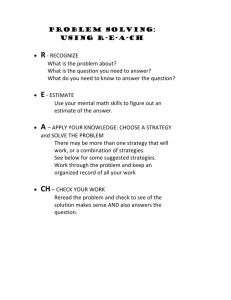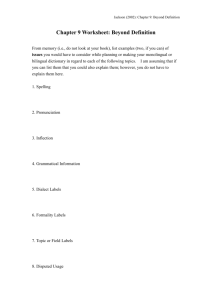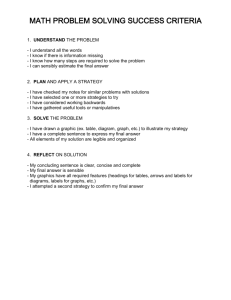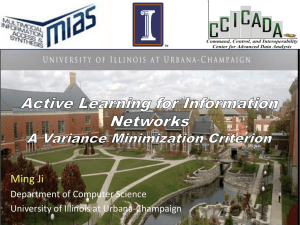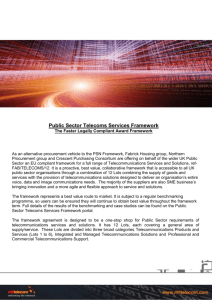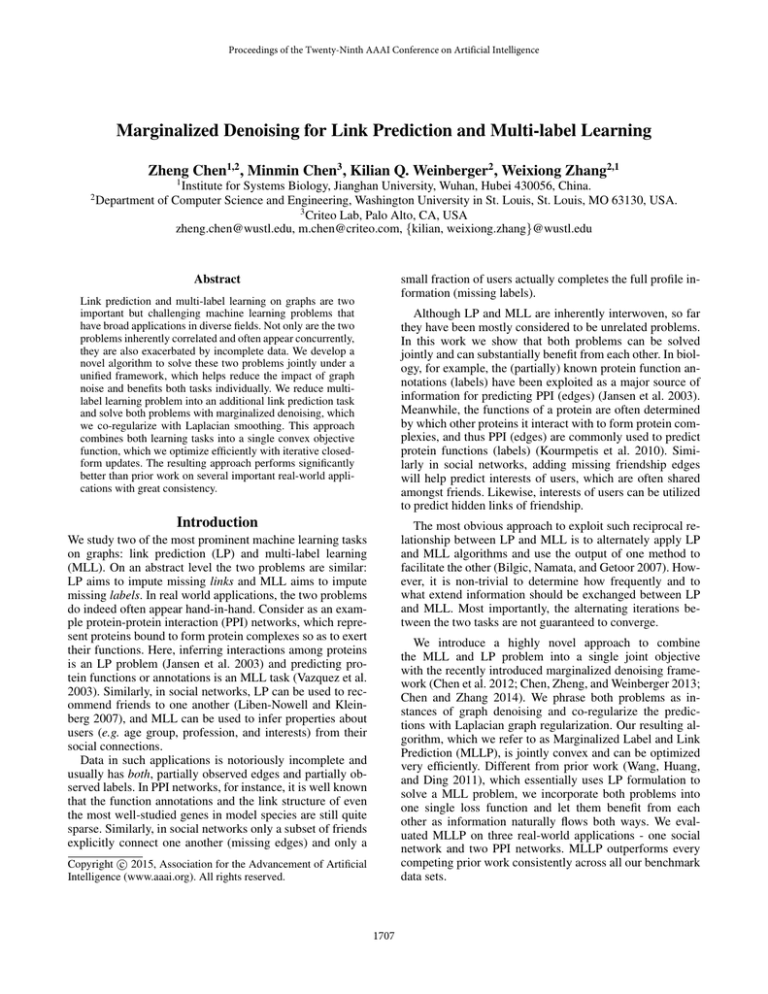
Proceedings of the Twenty-Ninth AAAI Conference on Artificial Intelligence
Marginalized Denoising for Link Prediction and Multi-label Learning
Zheng Chen1,2 , Minmin Chen3 , Kilian Q. Weinberger2 , Weixiong Zhang2,1
1
2
Institute for Systems Biology, Jianghan University, Wuhan, Hubei 430056, China.
Department of Computer Science and Engineering, Washington University in St. Louis, St. Louis, MO 63130, USA.
3
Criteo Lab, Palo Alto, CA, USA
zheng.chen@wustl.edu, m.chen@criteo.com, {kilian, weixiong.zhang}@wustl.edu
Abstract
small fraction of users actually completes the full profile information (missing labels).
Link prediction and multi-label learning on graphs are two
important but challenging machine learning problems that
have broad applications in diverse fields. Not only are the two
problems inherently correlated and often appear concurrently,
they are also exacerbated by incomplete data. We develop a
novel algorithm to solve these two problems jointly under a
unified framework, which helps reduce the impact of graph
noise and benefits both tasks individually. We reduce multilabel learning problem into an additional link prediction task
and solve both problems with marginalized denoising, which
we co-regularize with Laplacian smoothing. This approach
combines both learning tasks into a single convex objective
function, which we optimize efficiently with iterative closedform updates. The resulting approach performs significantly
better than prior work on several important real-world applications with great consistency.
Although LP and MLL are inherently interwoven, so far
they have been mostly considered to be unrelated problems.
In this work we show that both problems can be solved
jointly and can substantially benefit from each other. In biology, for example, the (partially) known protein function annotations (labels) have been exploited as a major source of
information for predicting PPI (edges) (Jansen et al. 2003).
Meanwhile, the functions of a protein are often determined
by which other proteins it interact with to form protein complexies, and thus PPI (edges) are commonly used to predict
protein functions (labels) (Kourmpetis et al. 2010). Similarly in social networks, adding missing friendship edges
will help predict interests of users, which are often shared
amongst friends. Likewise, interests of users can be utilized
to predict hidden links of friendship.
Introduction
The most obvious approach to exploit such reciprocal relationship between LP and MLL is to alternately apply LP
and MLL algorithms and use the output of one method to
facilitate the other (Bilgic, Namata, and Getoor 2007). However, it is non-trivial to determine how frequently and to
what extend information should be exchanged between LP
and MLL. Most importantly, the alternating iterations between the two tasks are not guaranteed to converge.
We study two of the most prominent machine learning tasks
on graphs: link prediction (LP) and multi-label learning
(MLL). On an abstract level the two problems are similar:
LP aims to impute missing links and MLL aims to impute
missing labels. In real world applications, the two problems
do indeed often appear hand-in-hand. Consider as an example protein-protein interaction (PPI) networks, which represent proteins bound to form protein complexes so as to exert
their functions. Here, inferring interactions among proteins
is an LP problem (Jansen et al. 2003) and predicting protein functions or annotations is an MLL task (Vazquez et al.
2003). Similarly, in social networks, LP can be used to recommend friends to one another (Liben-Nowell and Kleinberg 2007), and MLL can be used to infer properties about
users (e.g. age group, profession, and interests) from their
social connections.
Data in such applications is notoriously incomplete and
usually has both, partially observed edges and partially observed labels. In PPI networks, for instance, it is well known
that the function annotations and the link structure of even
the most well-studied genes in model species are still quite
sparse. Similarly, in social networks only a subset of friends
explicitly connect one another (missing edges) and only a
We introduce a highly novel approach to combine
the MLL and LP problem into a single joint objective
with the recently introduced marginalized denoising framework (Chen et al. 2012; Chen, Zheng, and Weinberger 2013;
Chen and Zhang 2014). We phrase both problems as instances of graph denoising and co-regularize the predictions with Laplacian graph regularization. Our resulting algorithm, which we refer to as Marginalized Label and Link
Prediction (MLLP), is jointly convex and can be optimized
very efficiently. Different from prior work (Wang, Huang,
and Ding 2011), which essentially uses LP formulation to
solve a MLL problem, we incorporate both problems into
one single loss function and let them benefit from each
other as information naturally flows both ways. We evaluated MLLP on three real-world applications - one social
network and two PPI networks. MLLP outperforms every
competing prior work consistently across all our benchmark
data sets.
c 2015, Association for the Advancement of Artificial
Copyright Intelligence (www.aaai.org). All rights reserved.
1707
Notation
Constructing a bi-relational graph
We first inject label information by augmenting the original graph G with additional nodes and edges. Specifically,
we introduce K new nodes, one per label. We refer to these
newly added nodes as label nodes and the original nodes
as data nodes. In addition, we create a link between the ith
data node and the k th label node if node i carries label k, i.e.
Yki = 1; see box 3 in Figure 1 for a schematic illustration.
The resulting bi-relational graph characterizes relationships
between two types of nodes, the data and label nodes, and
we use G ∈ {0, 1}(n+K)×(n+K) to denote the link matrix
of the new graph. G can be decomposed as
G Y>
G=
,
(2)
Y H
We consider the problems of LP and MLL on a graph
G = (G, Y) of n nodes in a transductive learning setting.
G ∈ {0, 1}n×n denotes a partially observed relational graph
between nodes, where Gij = 1 iff we observe a link between
nodes i and j, and Gij = 0, otherwise. For simplicity, we
consider binary graphs throughout the paper, but in practice our method can be easily extended to weighted graphs,
where Gij takes real-valued edge weights. Y ∈ {0, 1}K×n
represents partially observed labels of nodes, where K is the
total number of labels and Yki = 1 iff node i is observed to
be associated with the k th label, and Yki = 0, otherwise.
Note that each node can be associated with more than one
label. We denote the ith column of Y, i.e. the label vector
of node i, as yi and without loss of generality, we assume
the labels of the first l nodes, y1 , . . . , yl , are given (albeit
incomplete) and all the other labels are unknown.
where G is the adjacency matrix of the original graph, Y
encodes the observed association between data nodes and labels (or label nodes), and H, which may be all-zeros or some
prior that prescribes the similarities among labels. We use
the cosine similarity among observed labels, as suggested
before (Wang, Huang, and Ding 2011).
It is important to note that the bi-relational graph G is
considered to be only partially observed, because each of its
components: G, Y, and H may be incomplete. We will learn
to predict missing links on the augmented bi-relational graph
G instead of the original graph G. Adding links between
data and label nodes in G is another form for completing
Y, complementary to the graph Laplacian based method we
introduced in the previous section. It also serves as a key
component for linking LP and MLL.
Multi-label Learning on Relational Graphs
We first focus on the problem of inferring a more complete
label matrix Ŷ ∈ RK×n from a partially observed label matrix Y. (The matrix Ŷ can subsequently be thresholded to
yield hard label assignments.) Given a partially observed adjacency matrix G, we can formulate the problem as a classical graph-based semi-supervised learning problem (Zhou
and Schölkopf 2004):
2
(1)
argmin Tr(ŶLŶ> ) + α Ŷ − Y ,
Ŷ
F
where L = D − G is the graph LaplacianP
defined on graph
G and D is a diagonal matrix with Dii = j Gij . The first
term of (1) measures the smoothness of the predicted scores
Ŷ on the graph structure and encourages the scores of adjacent nodes to be similar. The second term of (1) penalizes
large deviations of the predictions from the given labels (and
increases numerical stability). The hyperparameter α > 0 adjusts the trade-off between these two objectives.
The optimization problem in (1) can be solved in a closed
form as Ŷ = αY(L + αI)−1 . In general, two different constants of α for trade off can be used: one for the initially
labeled nodes and the other for unlabeled nodes. This framework, in combination with alternative choices of the graph
Laplacian matrix L, takes several established graph-based
semi-supervised algorithms as special cases (up to some
scaling factors), e.g. the local and global consistent model
of Zhou and Schölkopf (2003), and the random-walk with
restart (RWR) model of Pan et al. (2004). In this study, we
will follow the graph-based semi-supervise learning framework defined in (1) as the centerpiece for MLL.
Marginalized denoising model for link prediction
Different from most prior work, we use the recently developed marginalized denoising framework for link prediction (Chen et al. 2012; Chen, Zheng, and Weinberger 2013;
Chen and Zhang 2014).
Consider the observed links in an “incomplete” birelational graph G as randomly sampled from an (unknown)
“complete” bi-relational graph G∗ . The goal for LP is to find
a linear mapping W to reverse the corruption process and
approximately reconstructs the “complete” graph G∗ from
∗
the “incomplete” graph G such that WG ≈ G .
Because G∗ is unknown, we cannot learn W directly. Instead, we construct an artificial training set of m further core 1, . . . , G
e m , by randomly removing
rupted graphs of G, G
edges with some probability p ∈ [0, 1]. We then train W to
reconstruct G from these further corrupted graphs with
m
1 X
e j k2 .
min
kG − WG
F
W m
j=1
Link Prediction on Bi-relational Graphs
(3)
If this corruption mechanism approximates how G was
∗
generated from the “complete” graph G , re-applying the
learned mapping W to G will approximate the “uncor∗
rupted” graph G . As far as the learning of W is concerned,
We now consider the LP problem of inferring missing links
in a partially observed graph G. Different from previous
work, we also incorporate the known, albeit incomplete, labels Y in the process.
1708
Figure 1: An illustration of MLLP. Each data node can be associated with one or more labels in a label set: Red, Green, and
Blue. The original graph is augmented into a bi-relational graph, G (Box 3). The joint model (Box 2) encourages agreement
between the predicted labels from MLL (Box 1) and the enriched labels from LP (Box 3).
Joint Objective
it is generally better to set m as large as possible. We therefore consider the limiting case, m → ∞, so that (3) becomes
h
i
e 2
min E kG − WGk
.
(4)
W
F
In this section we combine the LP and MLL problems into
a single joint objective, which allows information flow in
both directions. The key idea, which forms the cornerstone
of this study, is to establish the correspondence between LP
and MLL such that these two tasks can exchange information under a unified framework. Note that the second term
of the MLL objective (1), kŶ − Yk2F , penalizes large deviations of the learned scores Ŷ from observed labels Y.
These observed labels themselves, however, are notoriously
incomplete. Instead of relying completely on the original
observed labels, we encourage the two approaches, LP and
MLL, to agree with each other with respect to their label
predictions, i.e. we co-regularize the two predictions with
the term kŶ − Ŷ0 k2F . We include the closed form solution
for Ŷ0 , eq. (7), in this co-regularizer and combine it with the
two objectives (1) and (5) to obtain the final joint optimization:
2
1
>
> Tr ŶLŶ> + α Ŷ
−
(W
G
+
G
W
)
y g
y
g 2
F
{z
}
|
|
{z
}
e
P (G|G)
This expectation is analytically computable in closed
form (Chen et al. 2012). It is straightforward to show that
(4) can be rewritten as
min Tr(WQW> − 2(1 − p)WGG> ),
(5)
W
where Q = (1 − p)2 GG> + p(1 − p)diag(GG> ). Eq. (5)
describes a parabola and its solution can be computed in
closed form. Note that the expectation in (4) is still tractable
even for more general corruption models (Chen et al. 2012;
van der Maaten et al. 2013).
Because of the bi-relational nature of G, the mapping W
can be used for both label prediction and link prediction. To
simplify notation, let W = [Wg Wy ], where the subscripts g
and y denote the first n and last K rows of W respectively,
> >
and we can decompose G = [G>
g Gy ] (the first n and
the last K columns) accordingly. This approach can be used
naturally for both link and label prediction.
Link prediction. By the definition of bi-relational graph
G in (2), the original graph G corresponds to its upper-left
corner. We can tease out this part of the interpolated link
matrix as
1
>
Ĝdir = Wg Gg , Ĝundir = (Wg Gg + G>
g Wg ), (6)
2
where Ĝdir describes the solution in the scenario of directed
graphs and Ĝundir in the scenario of undirected graphs. (In
the case of undirected graphs it is advantageous to symmetrize the output after the mapping with W.)
Label prediction. Imputed links between the data and label nodes can be interpreted as predictions of labels. Regardless of the nature of the input graph, we consider these links
always undirected and we compute the predicted label matrix, Ŷ0 , via link prediction as
1
>
Ŷ0 = (Wy Gg + G>
(7)
y Wg ).
2
prediction smoothness
enriched label agreement
>
+ β Tr(WQW − 2(1 − p)WGG> ) .
|
{z
}
link prediction on bi-relational graph
(8)
This optimization is over Ŷ and W. The constant α ≥ 0
trades-off the co-regularization terms and β > 0 balances
the two tasks. Note that the last term is crucial for incorporating the original labels Y in G. Without it, the optimization
would yield a trivial all-zero solution for W and Ŷ. Figure 1
sketches the intuition behind the joint optimization.
The objective in (8) is jointly convex and quadratic in Ŷ
and W. This means that we can obtain the global solution
by solving both matrices in closed forms in an alternating
fashion. Algorithm 1 summarizes the joint optimization algorithm with detailed alternating update rules. Note that the
1709
most computationally intensive operations, the matrix inversions, conveniently involve only with sparse matrices and
are executed out the main loop.
Non-uniform co-regularization. In our formulation in
(8), the observed labels only enter the optimization in LP
(the third term). To propagate this information to the MLL
objective (first term), it makes sense to co-regularize the two
methods more for nodes that are accompanied with labels.
In practice, we use different α’s for nodes with and without
labels (αl , αu respectively). We have found empirically that
it is best to set αl αu when there are many unlabeled
nodes.
Stacked link prediction. Chen et al. (2012) suggest to
improve the performance of marginalized denoising in document representation through stacking. We observe a similar performance boost in our setting. In other words, after
solving (8) we “enrich” the graph G with the mapping W
and truncate all entries to be within [0, 1]. We then use this
enriched link matrix as the input for another round of optimization of (8). We repeat this process until the LP result
stops to improve on a hold-out set.
the same filtering steps as in the Yeast dataset, obtaining a
PPI graph of 4,877 nodes and a set of 267 distinct labels.
3) LiveJournal: the whole dataset describes a social network from an online blogging community of more than 3
million users (Yang and Leskovec 2012). We randomly sampled a subgraph of the network consisting of a connected
component of 11,921 users. Each user is associated with one
or more user-defined groups. Given the observed network
and the known groups associated with each user, the LP task
is to predict if two users are likely to establish friendship,
and the MLL task is to identify hidden user groups that a
user is associated with.
Methods. We compared our method MLLP to several existing methods that solve the MLL and LP separately. Three
state-of-the-art MLL algorithms that are designed to handle
incomplete labels, i.e. MLR-GL (Bucak, Jin, and Jain 2011),
I-BG (Wang, Huang, and Ding 2011), and ProtDM (Yu et
al. 2013), were chosen. We also included three state-of-theart LP methods: Kernel-based scores (Kernel) (Fouss et al.
2012), link propagation (LinkProp) (Kashima et al. 2009),
and supervised link prediction (SLP) (Al Hasan et al. 2006).
To demonstrate the benefit of solving MLL and LP jointly,
we included the marginalized denoising method (MDM) in
Eq. (4) on the bi-relational graph, and the graph-based regularization framework (GR) in Eq. (1) as the baselines. We
also include the alternating method (Alter) (Bilgic, Namata,
and Getoor 2007) as a baseline. There are numerous choices
of how the prediction results can be exchanged between
MDM and GR at each iteration in Alter. We choose to add
the 100 top-ranked edges predicted by MDM to the observed
graph for GR and add 10 top-ranked instances for each label predicted by GR to the known labels for MDM because
it leads to the best performance. We repeat this procedures
for 20 times. We set the hyper-parameters of all methods using 5-fold cross-validation, except the corruption noise p of
MLLP and MDM is set to a high value p = 0.95, throughout.
Experiment setup and evaluation metrics. Both MLL
and LP are essentially tasks to infer missing information
in a graph. To establish ground truth for comparing performance of the method considered, we removed labels and
edges in three ways. 1) We randomly removed a fraction,
γ ∈ {0.0, 0.1, 0.2, 0.3, 0.4}, of the existing edges. 2) We randomly selected 50% of the nodes and remove all label information from them (these are the MLL test nodes). 3) To simulate various degrees of incomplete training information, we
randomly removed a fraction δ ∈ {0.0, 0.1, 0.2, 0.3, 0.4} of
the label information Y of all remaining nodes. As there are
five choices for γ and δ we ultimately created 25 distinct
setups for training. For both MLL and LP, we reported the
AUC of the ROC curve (Huang and Ling 2005) of the reconstructed links and induced labels (on the testing nodes)
averaged over five runs along with standard deviations.
Performance of link prediction. Fig. 2 summarizes the
AUCs of the various methods for link prediction on the three
datasets. In the first row, we plot the average AUCs as a function of the fraction of missing links, γ.2 Here, we fixed the
Algorithm 1 Joint link prediction and multi-label learning
Input: Labels Y, Graph G, Parameters α, β > 0, and level of
corruption: 0 < p < 1
Output: link prediction scores Ĝ and label prediction scores Ŷ.
Set Hij =
yi> yj
,
||yi ||||yi ||
G = [G, Y> ; Y, H], L ← graph Lapla-
cian of G, P = (1−p)WGG> . Initialize Ŷ and W randomly.
−1
Z1 = ( α4 Gg G>
g + βQ)
>
α
Z2 = ( 4 Gy Gy + βQ)−1
Z3 = (L + αI)−1
repeat
>
>
Wy ← ( α2 (Ŷ − G>
y Wg )Gg + βPy )Z1
>
>
Wg ← ( α2 (Ŷ> − G>
g Wy )Gy + βPg )Z2
>
>
α
Ŷ ← 2 (Wy Gg + Gy Wg )Z3
until convergence
return Ŷ and Ĝ, as defined in (6)
Experimental Results
We evaluated MLLP, together with several other MLL and
LP algorithms on three real-world datasets, two of which
are from computational biology and the third is on social
networks.
Datasets. 1) Yeast: we extracted the yeast PPI graph from
HINT (Das and Yu 2012), which is a human-curated highquality PPI dataset. The functional annotations (labels) of
proteins were obtained from the SGD database1 . We kept
99 function labels that were associated with at least 20 proteins and removed proteins that were not annotated by any
of these 99 functions. This resulted in a graph consisting of
2,925 nodes annotated with at least one label.
2) Human: the human PPI graph was also taken from
HINT. The human proteins were annotated according to the
Gene Ontology (Consortium and others 2000). We followed
1
2
There is no result for γ = 0, as in this case there is no link to
be reconstructed.
http://www.yeastgenome.org/
1710
Figure 2: A comparison of various LP algorithms and MLLP. The graphs show the averaged AUC scores as a function of
missing links γ and missing labels δ. The standard deviation of the AUCs are shown as error bars.
Figure 3: Comparison of various MLL algorithms and MLLP. The graphs show the averaged AUC scores as a function of
missing links γ and missing labels δ. The standard deviations of the AUCs are shown by error bars.
fraction of missing training labels to δ = 0.2. In the second row, we varied δ and set γ = 0.2. The baseline model,
MDM, outperforms the three state-of-the-art methods, Kernel, LinkProp, and SLP, for all settings on the Yeast and Human datasets by a relatively large margin. It indicates that the
marginalized denoising model is indeed promising in link
prediction. Its performance on the LiveJournal dataset is not
satisfactory though. We hypothesize that this may be due
to the relatively high sparseness (lower graph density and
node degree) of the graph, which makes it difficult to recover
the hidden link correlations solely through corruption and
denoising. The Alter method outperforms MDM when the
fraction of missing labels (δ) is small, but its performance
decreases as δ increases. This is probably because when δ
is large, the MLL part, GR, is more likely to make wrong
predictions and thus makes the bi-relational graph of MDM
unreliable. Our method MLLP, on the other hand, consistently outperforms the other methods on all three datasets.
In particular, it boosts the performance of MDM significantly on the LiveJournal dataset, which indicates that solving the MLL and LP problems jointly significantly improves
the performance of the LP accuracy. As expected, when the
fraction of removed links γ increases, the overall LP AUCs
decreases. However, removing labels (increased δ) has a less
pronounced effect on the LP performance on the Yeast and
Human datasets, probably because these two networks are
relatively dense enough for the LP algorithms to infer links
from the observed links alone.
Performance of multi-label learning Fig. 3 summarizes
the MLL performance of various methods following the
same setting as in Fig. 2. As shown, the baseline method
GR for MLL is not as powerful as MDM for LP. It performs
worse than most of the existing methods. The Alter improves
upon GR in almost all settings. It is worth to note that as the
fraction of missing links (γ) increases, the improvement of
Alter becomes marginal. This is similar to the effect of δ on
Alter in the LP task; i.e. the alternating method is prone to
aggregating wrong predictions made by previous iterations
when γ is large. Our new method MLLP enhanced with the
link prediction component, is able to considerably improve
its performance. MLLP outperforms almost all other methods across different settings except for LiveJournal when
1711
run of MLLP until convergence on the LiveJournal dataset
and around 23s on the Human dataset (without GPU 7m and
1m respectively). For perfect reproducibility, we provide the
source code and data sets online at http://www.cse.wustl.edu/
∼chenz/codes/mllp.tar.gz.
Related Works and Discussion
Link prediction. The existing works on LP can be roughly
grouped into three categories. 1) Similarity based methods,
e.g. Adamic-Adar Index (Adamic and Adar 2003), extract
similarity scores between nodes based on graph topologies.
The scores are later thresholded or ranked to form links. 2)
Latent factor models explain the observed adjacency matrix
using a small number of latent factors. The latent factors are
usually learned through matrix factorization (Koren, Bell,
and Volinsky 2009) or Bayesian models (Miller, Griffiths,
and Jordan 2009). 3) Supervised methods treat LP as binary
classification problems. MLLP for LP can be considered as
a special instance of supervised learning methods, where
we learn the similarity scores using a supervised learning
scheme trained on conceptually “infinitely many” training
examples. Our work may be most similar to the work (Chen
and Zhang 2014), who already explore marginalized denoising for LP, however do not incorporate MLL.
Multi-label learning. Many existing works on MLL explicitly incorporate graph structure into models such as the
traditional graph-based semi-supervised models (Zhou et al.
2003) and collective classification methods (Kong, Shi, and
Philip 2011). A few existing work explicitly addresses the
incompleteness of the class labels though. MLR-GL (Bucak, Jin, and Jain 2011) extends the multi-label ranking approaches with group lasso technique to reduce the penalty on
possible unassigned labels. I-BG (Wang, Huang, and Ding
2011) constructs a similar bi-relational graph but uses Random Walk with Restart (RWR) model to learn the relevance
between a label and a data nodes. MLL can also be cast as
a hyperedge prediction problem over hypergraphs (Sun, Ji,
and Ye 2008). In fact, the constructed bi-relational graph can
be viewed as a dyadic version of a hypergraph, where a hyperedge is used to connect a label node with multiple data
nodes. Using the dyadic edges, we are able to perform MLL
and LP jointly.
Joint link prediction and multi-label learning. Although a collection of methods have been developed to solve
the LP and MLL problems independently, little effort has
been devoted to solving the two problems jointly. There are
works that have alluded to the close connection between the
two problems. For example, the graph Laplacian (Zhou and
Schölkopf 2004; Fouss et al. 2012) and variants of graph kernels serve as the main building blocks for many similaritybased LP and MLL methods. Bilgic et. al. (2007) proposed
to alternately apply LP and MLL algorithms and showed that
it can improve the performance of both tasks. However, it is
difficult to prevent unreliable predictions being exchanged
from one task to the other. This problem is further exacerbated by missing links and labels as shown in our experiment. MLLP, on the other hand, combines LP and MLL
seamlessly into a joint optimization and enables both tasks
to benefit from each other.
Figure 4: Relative improvements of MLLP over the baseline
methods MDM for LP (upper row) and GR for MLL (lower
row). The plots show the relative increase in LP AUC (%)
and MLL AUC (%) as the fractions of missing labels (xaxis) and missing links (y-axis) varies.
γ = 0, where it is comparable to I-BG. It is worth noting
that MLLP improves upon the baselines (MDM for LP and
GR for MLL) more pronouncedly as either γ or δ increases.
Comparison of the joint model with the baselines. We
define the relative improvement of MLLP over the baselines
0
as a1a−a
, where a0 is the AUC score of MDM for LP or that
0
of GR for MLL, and a1 is the corresponding AUC score of
MLLP. Fig. 4 shows the relative improvement in percentage
under all 25 settings with varying fractions of missing labels (y-axis) and links (x-axis). A clear trend emerges showing that the relative improvement of MLLP upon the baselines increases as the fraction of missing labels and/or links
increases. When the fraction of missing links is high, e.g.
γ = 0.4, MLLP achieves more than 7% boost over MDM
on the LiveJournal dataset for LP, and more than 10% improvement over GR on the Yeast and LiveJournal dataset for
MLL. The improvement, especially on the Yeast and Human
datasets for LP, is less evident as the fraction of missing labels δ increases. This is consistent with our previous hypothesis that the labels in these two datasets adds relatively less
information as the baseline is able to infer links from the
observed links alone.
Running time. The time complexity of MLLP is O(n3 )
due to matrix inversions and multiplications. The algorithm
usually converges within 10 to 20 iterations. On a server
with two 8-core Intel Xeon E5-2650@2.60GHz CPUs and
128GB RAM, our MATLABT M implementation (accelerated with an NVIDIA K40 GPU) required about 170s for a
1712
Acknowledgments
Koren, Y.; Bell, R.; and Volinsky, C. 2009. Matrix factorization techniques for recommender systems. Computer
42(8):30–37.
Kourmpetis, Y.; van Dijk, A.; Bink, M.; van Ham, R.; and
Ter Braak, C. 2010. Bayesian markov random field analysis
for protein function prediction based on network data. PloS
one 5(2).
Liben-Nowell, D., and Kleinberg, J. 2007. The linkprediction problem for social networks. Journal of the
American society for information science and technology
58(7):1019–1031.
Miller, K.; Griffiths, T.; and Jordan, M. 2009. Nonparametric latent feature models for link prediction. In NIPS,
volume 9, 1276–1284.
Pan, J.; Yang, H.; Faloutsos, C.; and Duygulu, P. 2004. Automatic multimedia cross-modal correlation discovery. In
KDD, 653–658. ACM.
Sun, L.; Ji, S.; and Ye, J. 2008. Hypergraph spectral learning
for multi-label classification. In KDD, 668–676. ACM.
van der Maaten, L.; Chen, M.; Tyree, S.; and Weinberger,
K. 2013. Learning with marginalized corrupted features. In
ICML, volume 28, 410–418.
Vazquez, A.; Flammini, A.; Maritan, A.; and Vespignani, A. 2003. Global protein function prediction from
protein-protein interaction networks. Nature biotechnology
21(6):697–700.
Wang, H.; Huang, H.; and Ding, C. 2011. Image annotation
using bi-relational graph of images and semantic labels. In
CVPR, 793–800. IEEE.
Yang, J., and Leskovec, J. 2012. Defining and evaluating network communities based on ground-truth. In ICDM,
745–754.
Yu, G.; Domeniconi, C.; Rangwala, H.; and Zhang, G. 2013.
Protein function prediction using dependence maximization. In Machine Learning and Knowledge Discovery in
Databases. Springer. 574–589.
Zhou, D., and Schölkopf, B. 2004. A regularization framework for learning from graph data. In ICML 2004 Workshop on Statistical Relational Learning and its Connections
to Other Fields, 132.
Zhou, D.; Bousquet, O.; Lal, T. N.; Weston, J.; and
Schölkopf, B. 2003. Learning with local and global consistency. In NIPS, volume 16, 321–328.
ZC and WZ are supported in part by Natural Science Foundation of China (31300999), the municipal government of
Wuhan, Hubei, China (2014070504020241 and the Talent
Development Program), and an internal research grant of
Jianghan University, Wuhan, China, as well as by United
States National Institutes of Health (R01GM100364). KQW
is supported by NSF grants IIS-1149882, EFRI-1137211.
Any opinions, findings, and conclusions or recommendations expressed in this material are those of the author(s) and
do not necessarily reflect the views of the National Science
Foundation.
References
Adamic, L., and Adar, E. 2003. Friends and neighbors on
the web. Social networks 25(3):211–230.
Al Hasan, M.; Chaoji, V.; Salem, S.; and Zaki, M. 2006.
Link prediction using supervised learning. In SDM06: Workshop on Link Analysis, Counter-terrorism and Security.
Bilgic, M.; Namata, G. M.; and Getoor, L. 2007. Combining collective classification and link prediction. In Data
Mining Workshops, 2007. ICDM Workshops 2007. Seventh
IEEE International Conference on, 381–386. IEEE.
Bucak, S.; Jin, R.; and Jain, A. 2011. Multi-label learning
with incomplete class assignments. In CVPR, 2801–2808.
IEEE.
Chen, Z., and Zhang, W. 2014. A marginalized denoising
method for link prediction in relational data. In SDM.
Chen, M.; Xu, Z.; Weinberger, K.; and Sha, F. 2012.
Marginalized denoising autoencoders for domain adaptation. In ICML. ACM. 767–774.
Chen, M.; Zheng, A.; and Weinberger, K. 2013. Fast image
tagging. In ICML, volume 28, 1274–1282.
Consortium, G. O., et al. 2000. Gene ontology: tool for the
unification of biology. Nature genetics 25(1):25–29.
Das, J., and Yu, H. 2012. Hint: High-quality protein interactomes and their applications in understanding human
disease. BMC systems biology 6:92.
Fouss, F.; Francoisse, K.; Yen, L.; Pirotte, A.; and Saerens,
M. 2012. An experimental investigation of kernels on graphs
for collaborative recommendation and semisupervised classification. Neural networks 31:53–72.
Huang, J., and Ling, C. X. 2005. Using auc and accuracy in
evaluating learning algorithms. Knowledge and Data Engineering, IEEE Transactions on 17(3):299–310.
Jansen, R.; Yu, H.; Greenbaum, D.; Kluger, Y.; Krogan,
N. J.; Chung, S.; Emili, A.; Snyder, M.; Greenblatt, J. F.;
and Gerstein, M. 2003. A bayesian networks approach for
predicting protein-protein interactions from genomic data.
Science 302(5644):449–453.
Kashima, H.; Kato, T.; Yamanishi, Y.; Sugiyama, M.; and
Tsuda, K. 2009. Link propagation: A fast semi-supervised
learning algorithm for link prediction. In SDM, volume 9,
1099–1110. SIAM.
Kong, X.; Shi, X.; and Philip, S. Y. 2011. Multi-label collective classification. In SDM, volume 11, 618–629. SIAM.
1713

